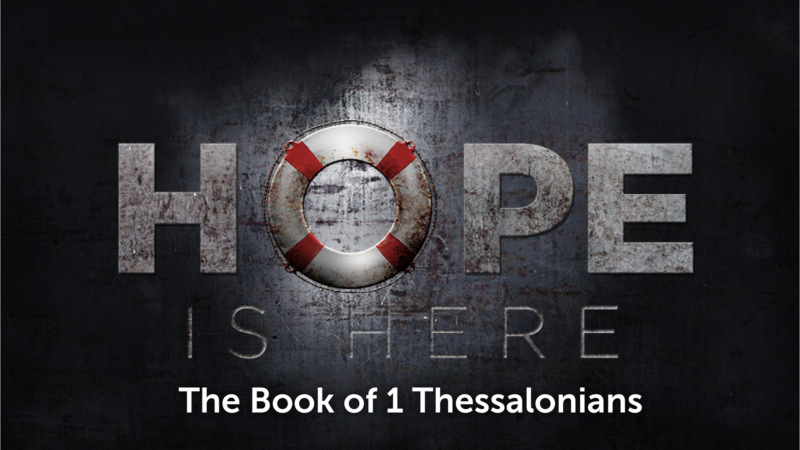In a world gripped by uncertainty—pandemics, economic shifts, and global conflicts—where do we find unshakable hope? The Book of 1 Thessalonians offers a timeless answer: in the faithful promises of God and the glorious return of our lord and Saviour Jesus Christ. Written nearly 2,000 years ago, the Book of 1 Thessalonians is one of the earliest letters written by the Apostle Paul and holds a special place in the New Testament. It addresses the young Christian church in Thessalonica—a community full of faith, love, and perseverance despite persecution. This epistle not only encourages believers to remain steadfast in their faith but also centers on two major themes: hope in Christ and the return of the Lord Jesus.

Why does 1 Thessalonians matter today? In an era of “doomscrolling” and fleeting optimism, Paul’s words remind us that true hope isn’t wishful thinking—it’s anchored in Christ’s second coming. As we explore this shortest New Testament book (only 89 verses!), we will uncover how it addresses persecution, holy living, and the rapture, sparking a renewed sense of purpose. Let us journey back to ancient Thessalonica and discover the hope that transforms despair into eager expectation.
Historical Context of 1 Thessalonians: A Church Born in Fire
To truly appreciate the Book of 1 Thessalonians, we must step into the bustling port city of Thessalonica around AD 50-51. Located in modern-day Greece (Thessaloniki), this Macedonian hub was a crossroads of trade, culture, and Roman influence. With a population exceeding 200,000, it was a melting pot of Greeks, Romans, Jews, and Gentiles, where Emperor worship clashed with emerging Christianity. Paul arrived here during his second missionary journey along with Silas and Timothy, as detailed in Acts 17:1-9.
Understanding the Book of 1 Timothy: Leadership and Doctrine
Paul’s time in Thessalonica was brief but explosive; his stay was cut short due to persecution from hostile groups. Fresh from Philippi’s imprisonment, he preached in the synagogue for three Sabbaths, proclaiming Jesus as the Messiah. Many Jews, devout Greeks, and prominent women converted, forming the nucleus of the Thessalonian church. However, opposition erupted quickly. Jealous Jewish leaders accused Paul of defying Caesar by declaring Jesus as king, inciting a mob that dragged Jason (a host to Paul) before authorities. Paul, Silas and Timothy fled by night to Berea, then Athens, leaving the fledgling church vulnerable to persecution. This backdrop of hostility shapes 1 Thessalonians.
Concerned about the new believers, Paul sent Timothy back to check on their faith and spiritual growth. Timothy’s positive report inspired Paul to write this encouraging letter (1 Thessalonians 3:6–8). Written from Corinth shortly after (around AD 50-51), the letter responds to reports from Timothy about the church’s steadfastness despite trials. Paul’s purpose? To encourage perseverance, clarify misconceptions about Christ’s return, and urge holy living. Unlike his more doctrinal letters (e.g., Romans), 1 Thessalonians pulses with pastoral warmth—a father’s heart for his spiritual children.
Understanding this context reveals why Paul emphasizes hope: the Thessalonians faced not just social ostracism but life-threatening hostility, mirroring early Christian struggles worldwide.
Authorship, Date, and Structure: The Blueprint of Paul’s Earliest Epistle
Scholars widely affirm Pauline authorship for 1 Thessalonians, making it one of his earliest letters—predating Galatians and 1 Corinthians. Internal evidence abounds: the personal tone (“we always thank God for all of you,” 1:2), references to Paul’s ministry (2:1-12), and greetings from Silvanus (Silas) and Timothy (1:1) align with Acts’ narrative. No serious challenges exist, unlike debates over Ephesians or the pastorals.
Dated to AD 50-51, the book of 1 Thessalonians was written from Corinth after Timothy’s return from Thessalonica (3:6). This timing is crucial: mere months after Paul’s departure, the church endured intensified persecution, prompting his affectionate reassurance.
Understanding the Book of 2 Peter: Knowledge and Growth
Structurally, 1 Thessalonians unfolds in five chapters, blending thanksgiving, defense, exhortation, and prophecy. It is not systematic theology but relational dialogue:
- Chapters 1-3: Affirmation and reflection on faith in action.
- Chapters 4-5: Instruction on sanctification and eschatology.
Chapter-by-Chapter Breakdown: Unpacking the Message of Hope and Return
Now, let’s dissect 1 Thessalonians chapter by chapter, highlighting verses that illuminate hope and Christ’s return. This breakdown reveals Paul’s pastoral genius—comforting the afflicted while igniting eschatological fire.
Chapter 1: A Model Church and the Gospel’s Power
Paul opens with effusive thanksgiving (1:2-3), praising the Thessalonians’ triad of virtues: faith that works, love that labors, and hope steadfast in Christ. These aren’t abstract; they’re evident in their “turning to God from idols” (1:9), a radical shift in a pagan city.
The chapter’s heartbeat is election and imitation (1:4-10). God chose them, the gospel came “not only in word, but also in power” (1:5), and they became imitators of Paul, the Lord, and ultimately God (1:6). Their faith echoed across Macedonia and Achaia (1:8), a testament to evangelism’s ripple effect.
Hope emerges in 1:10: waiting for “God’s Son from heaven, whom he raised from the dead—Jesus, who rescues us from the coming wrath.” Here, the return of Christ in 1 Thessalonians is introduced as deliverance, not dread. Amid persecution, this verse reframes suffering as temporary, pointing to eternal rescue.
Chapter 2: Paul’s Bold Ministry and Fatherly Care
Defending his motives, Paul recounts his Thessalonian visit: not for greed or glory, but “like a nursing mother” (2:7) and “father” (2:11) tenderly caring for them. He worked night and day to avoid burdening them (2:9), preaching the gospel boldly despite opposition (2:2).
Understanding the Book of 1 Peter: Hope and Holiness
This chapter counters slander—Jews who expelled him (2:14-16)—by affirming the gospel’s cost. The Thessalonians suffered like Judean churches, imitating Christ’s passion (2:15). Yet, Paul’s separation grieves him (2:17-20), culminating in joy: “you are our glory and joy” (2:20).
Hope shines in 2:19: crowns of boasting before the Lord at His coming. Hope in 1 Thessalonians is relational—anticipated reunion with Christ and believers, turning ministry trials into triumphant expectation.
Chapter 3: Timothy’s Report and Unceasing Prayer
Anxiety drove Paul to send Timothy (3:1-5), fearing the tempter’s sway. Timothy’s report? The church stands firm in faith and love (3:6-7), alleviating Paul’s distress.
Prayer dominates (3:9-13): for increased love, strengthened hearts, and blamelessness at Christ’s return (3:13). This “parousia” (Greek for arrival/coming) underscores eschatological holiness.
The chapter models vulnerability—Paul’s “distress and affliction” (3:7)—yet pivots to joy. For us, it teaches sending encouragers during trials and praying expectantly for perseverance.
Chapter 4: Holy Living and the Rapture Revealed
Shifting to exhortations, Paul urges sexual purity (4:3-8), brotherly love (4:9-10), and diligent work (4:11-12) to win outsiders’ respect. These practical ethics flow from God’s call to holiness (4:7).
Understanding the Book of 2 Timothy: Perseverance and Scripture
The climax: the rapture (4:13-18). Concerned for deceased believers missing Christ’s return, Paul comforts: “We do not want you to be uninformed about those who sleep in death” (4:13). At the trumpet’s sound, the dead in Christ rise first, then living believers are “caught up” (harpazo, root of “rapture”) with them to meet the Lord in the air (4:16-17). “Encourage one another with these words” (4:18)—hope’s antidote to grief.
Chapter 5: The Day of the Lord and Final Charges
Like a “thief in the night” (5:2), Christ’s return surprises the unprepared. Believers, as “children of light” (5:5), watch vigilantly, donning faith, love, and salvation’s helmet (5:8, echoing Ephesians 6).
Paul closes with rapid-fire imperatives: respect leaders (5:12-13), live peaceably (5:13), rejoice always (5:16), pray continually (5:17), give thanks (5:18), test prophecies (5:20-21), and hold fast to good (5:21). Greetings and a benediction seal it (5:23-28).
Hope culminates in 5:23-24: God sanctifies completely, preserving spirit, soul, and body “blameless at the coming of our Lord Jesus Christ.” Faithful is He who calls!
This breakdown shows 1 Thessalonians as a symphony of comfort, correction, and call to readiness.
Main Themes in the Book of 1 Thessalonians
1. Hope in the Midst of Affliction
A major theme throughout the letter is hope. Paul commends the Thessalonian believers for their steadfast faith despite trials:
Understanding the Book of 2 Thessalonians: Endurance and Warning
“We remember before our God and Father your work produced by faith, your labor prompted by love, and your endurance inspired by hope in our Lord Jesus Christ.”
— 1 Thessalonians 1:3 (NIV)
This hope was not a vague optimism; it was rooted in the assurance of Christ’s resurrection and His promise to return. Even when faced with persecution and loss, the believers held on to their faith, knowing that their suffering was temporary and their reward eternal.
Hope is a defining mark of Christian life. It sustains believers during adversity and inspires them to live with eternal perspective. In modern times, this same message speaks directly to us: no matter the hardship, hope in Christ never disappoints.
2. The Return of the Lord Jesus Christ
The second dominant theme in 1 Thessalonians is the Second Coming of Christ. Paul mentions Christ’s return in every chapter, emphasizing the believer’s readiness and the comfort it brings.
In 1 Thessalonians 4:16–17 (NIV), Paul describes this event vividly:
“For the Lord himself will come down from heaven, with a loud command, with the voice of the archangel and with the trumpet call of God, and the dead in Christ will rise first. After that, we who are still alive and are left will be caught up together with them in the clouds to meet the Lord in the air. And so we will be with the Lord forever.”
Understanding the Book of 2 John: Truth and Love
This passage—often referred to as the “Rapture passage”—has become a cornerstone of Christian eschatological teaching. Paul wanted to comfort believers who were grieving the death of loved ones, assuring them that those who died in Christ would share equally in His coming glory.
The message is clear: the return of Jesus is not a reason for fear but for joy and anticipation. It’s the ultimate fulfillment of the believer’s hope.
3. Holiness and Christian Conduct
While Paul encouraged hope, he also emphasized the need for holy living. He urged the Thessalonians to walk in a manner worthy of God:
“It is God’s will that you should be sanctified: that you should avoid sexual immorality; that each of you should learn to control your own body in a way that is holy and honorable.”
— 1 Thessalonians 4:3–4 (NIV)
Sanctification—living a life set apart for God—is a vital response to the hope believers have in Christ. Paul reminded them that holiness was not optional but essential, especially in a society filled with moral corruption.
In today’s culture, where moral compromise is often justified, the call to purity and integrity remains relevant. Our anticipation of Christ’s return should motivate us to live righteously and reflect His character in all we do.
4. Encouragement and Comfort
Another key theme is encouragement. Paul frequently expressed affection for the Thessalonian church, describing them as his “joy and crown” (1 Thessalonians 2:19–20). He reassured them that even though they faced persecution, their faith was a testimony to others.
The apostle’s compassion teaches a vital lesson about Christian community: believers are meant to build each other up, not tear each other down. In a world filled with negativity, encouragement is a ministry of healing and hope.
“Therefore encourage one another and build each other up, just as in fact you are doing.”
— 1 Thessalonians 5:11 (NIV)
This verse serves as a timeless reminder that faith flourishes best in an environment of love, support, and mutual encouragement.
Understanding the Book of 3 John: Hospitality and Truth
5. The Day of the Lord and Vigilance
Paul also warns the church about the Day of the Lord, emphasizing vigilance and readiness:
“For you know very well that the day of the Lord will come like a thief in the night.”
— 1 Thessalonians 5:2 (NIV)
He contrasts believers—“children of the light”—with those living in darkness. Christians are called to remain spiritually alert, wearing the “breastplate of faith and love” and the “helmet of the hope of salvation” (1 Thessalonians 5:8).
This passage underscores that the return of Christ should shape our daily lives. Believers are not to be passive or complacent but to live with purpose, self-control, and readiness for the coming King.
Lessons from 1 Thessalonians for Today’s Believers
1. True Hope Transcends Circumstances
Christian hope is not dependent on favorable conditions. The Thessalonian church flourished amid persecution, teaching us that faith rooted in Christ endures any hardship.
2. The Return of Christ Is a Source of Comfort
Believers need not fear the future. The promise of Christ’s return assures us that justice, restoration, and eternal joy await the faithful.
3. Holiness Is the Proper Response to Grace
Grace is not a license for sin but a motivation for purity. A life of holiness honors God and prepares us for His return.
4. Community Encouragement Builds Strong Faith
Paul’s affectionate words demonstrate the power of encourMemorable Verses from 1 Thessalonians
Understanding the Book of 1 John: Love and Fellowship
Here are a few key passages that capture the essence of the letter:
- “Rejoice evermore, pray without ceasing, in everything give thanks; for this is the will of God for you in Christ Jesus.” — 1 Thessalonians 5:16–18
- “For God did not appoint us to suffer wrath but to receive salvation through our Lord Jesus Christ.” — 1 Thessalonians 5:9
- “The one who calls you is faithful, and he will do it.” — 1 Thessalonians 5:24
Conclusion
The Book of 1 Thessalonians is a beacon of hope and encouragement for all believers. It reminds us that faith can thrive even in persecution, that holiness is possible in a corrupt world, and that the promise of Christ’s return gives meaning to our waiting.
Paul’s message to the Thessalonians remains as relevant as ever: hold fast to your faith, live in holiness, encourage one another, and look forward with confident hope to the day when Christ will return in glory.
In times of uncertainty, despair, or moral decline, this ancient letter speaks powerfully to the modern church—reminding us that our ultimate hope lies not in worldly achievements but in the sure return of our Savior.
Memorable Verses from 1 Thessalonians
Here are a few key passages that capture the essence of the letter:
- “Rejoice evermore, pray without ceasing, in everything give thanks; for this is the will of God for you in Christ Jesus.” — 1 Thessalonians 5:16–18
- “For God did not appoint us to suffer wrath but to receive salvation through our Lord Jesus Christ.” — 1 Thessalonians 5:9
- “The one who calls you is faithful, and he will do it.” — 1 Thessalonians 5:24
Conclusion
The Book of 1 Thessalonians is a beacon of hope and encouragement for all believers. It reminds us that faith can thrive even in persecution, that holiness is possible in a corrupt world, and that the promise of Christ’s return gives meaning to our waiting.
Paul’s message to the Thessalonians remains as relevant as ever: hold fast to your faith, live in holiness, encourage one another, and look forward with confident hope to the day when Christ will return in glory.
In times of uncertainty, despair, or moral decline, this ancient letter speaks powerfully to the modern church—reminding us that our ultimate hope lies not in worldly achievements but in the sure return of our Savior.
FAQs: Common Questions on Understanding 1 Thessalonians
What is the main message of 1 Thessalonians?
The core message is encouragement for a persecuted church, emphasizing holy living, the resurrection of believers, and the hope of Christ’s imminent return.
Does 1 Thessalonians teach the rapture?
Yes, chapter 4:16-17 describes believers being “caught up” to meet the Lord, a foundational text for rapture theology.
How long is the Book of 1 Thessalonians?
It spans five chapters with 89 verses, making it the shortest Pauline epistle.
Who wrote 1 Thessalonians and why?
Apostle Paul, with Silvanus and Timothy, wrote it around AD 50-51 to comfort and instruct the Thessalonian church facing trials.
What does ‘parousia’ mean in 1 Thessalonians?
Parousia refers to the “coming” or “arrival” of Christ, highlighting His personal, visible return.
Last modified: October 21, 2025
